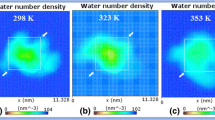Abstract.
The chaperone behaviour of bovine serum albumin was compared with that of α-crystallin. The chaperone activity was assessed by measuring: (i) the ability to antagonize protein aggregation induced by heat; (ii) the capability to protect the activity of thermally stressed enzymes and (iii) the effectiveness in assisting the functional recovery of chemically denatured sorbitol dehydrogenase. Despite the lack of structural analogies, both proteins show several functional similarities in preventing inactivation of thermally stressed enzymes and in reactivating chemically denatured sorbitol dehydrogenase. As with α-crystallin, the chaperone action of bovine serum albumin appears to be ATP independent. Bovine serum albumin appears significantly less effective than α-crystallin only in preventing thermally induced protein aggregation. A possible relationship between chaperone function and structural organization is proposed. Together, our results indicate that bovine serum albumin acts as a molecular chaperone and that, for its particular distribution, can be included in the extracellular chaperone family.
Similar content being viewed by others
Author information
Authors and Affiliations
Corresponding author
Additional information
Received 29 August 2005; received after revision 23 September 2005; accepted 12 October 2005
Rights and permissions
About this article
Cite this article
Marini, I., Moschini, R., Corso, A.D. et al. Chaperone-like features of bovine serum albumin: a comparison with α-crystallin. Cell. Mol. Life Sci. 62, 3092–3099 (2005). https://doi.org/10.1007/s00018-005-5397-4
Published:
Issue Date:
DOI: https://doi.org/10.1007/s00018-005-5397-4




